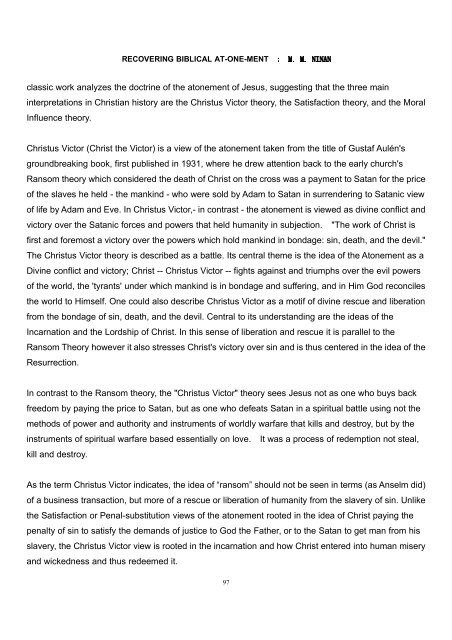Atonement
You also want an ePaper? Increase the reach of your titles
YUMPU automatically turns print PDFs into web optimized ePapers that Google loves.
RECOVERING BIBLICAL AT-ONE-MENT : M.<br />
M. M. NINAN<br />
classic work analyzes the doctrine of the atonement of Jesus, suggesting that the three main<br />
interpretations in Christian history are the Christus Victor theory, the Satisfaction theory, and the Moral<br />
Influence theory.<br />
Christus Victor (Christ the Victor) is a view of the atonement taken from the title of Gustaf Aulén's<br />
groundbreaking book, first published in 1931, where he drew attention back to the early church's<br />
Ransom theory which considered the death of Christ on the cross was a payment to Satan for the price<br />
of the slaves he held - the mankind - who were sold by Adam to Satan in surrendering to Satanic view<br />
of life by Adam and Eve. In Christus Victor,- in contrast - the atonement is viewed as divine conflict and<br />
victory over the Satanic forces and powers that held humanity in subjection. "The work of Christ is<br />
first and foremost a victory over the powers which hold mankind in bondage: sin, death, and the devil."<br />
The Christus Victor theory is described as a battle. Its central theme is the idea of the <strong>Atonement</strong> as a<br />
Divine conflict and victory; Christ -- Christus Victor -- fights against and triumphs over the evil powers<br />
of the world, the 'tyrants' under which mankind is in bondage and suffering, and in Him God reconciles<br />
the world to Himself. One could also describe Christus Victor as a motif of divine rescue and liberation<br />
from the bondage of sin, death, and the devil. Central to its understanding are the ideas of the<br />
Incarnation and the Lordship of Christ. In this sense of liberation and rescue it is parallel to the<br />
Ransom Theory however it also stresses Christ's victory over sin and is thus centered in the idea of the<br />
Resurrection.<br />
In contrast to the Ransom theory, the "Christus Victor" theory sees Jesus not as one who buys back<br />
freedom by paying the price to Satan, but as one who defeats Satan in a spiritual battle using not the<br />
methods of power and authority and instruments of worldly warfare that kills and destroy, but by the<br />
instruments of spiritual warfare based essentially on love. It was a process of redemption not steal,<br />
kill and destroy.<br />
As the term Christus Victor indicates, the idea of “ransom” should not be seen in terms (as Anselm did)<br />
of a business transaction, but more of a rescue or liberation of humanity from the slavery of sin. Unlike<br />
the Satisfaction or Penal-substitution views of the atonement rooted in the idea of Christ paying the<br />
penalty of sin to satisfy the demands of justice to God the Father, or to the Satan to get man from his<br />
slavery, the Christus Victor view is rooted in the incarnation and how Christ entered into human misery<br />
and wickedness and thus redeemed it.<br />
97


















